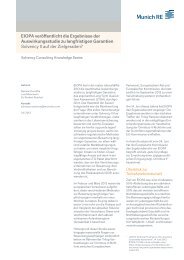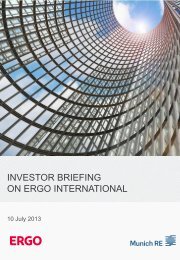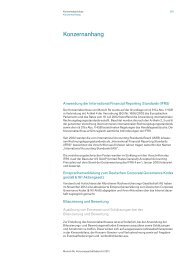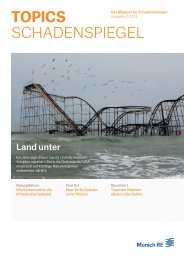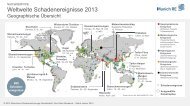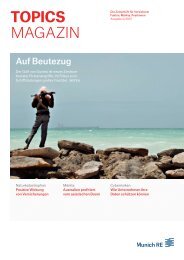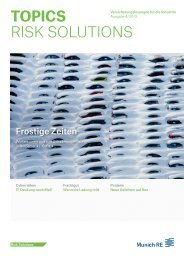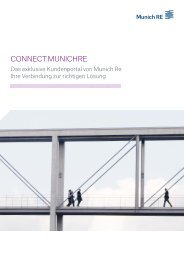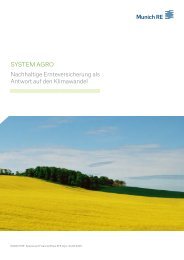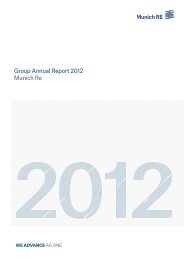Munich Re Group Annual Report 2006 (PDF, 1.8
Munich Re Group Annual Report 2006 (PDF, 1.8
Munich Re Group Annual Report 2006 (PDF, 1.8
Create successful ePaper yourself
Turn your PDF publications into a flip-book with our unique Google optimized e-Paper software.
<strong>Munich</strong> <strong>Re</strong> <strong>Group</strong> <strong>Annual</strong> <strong>Re</strong>port <strong>2006</strong> Management report_Financial situation<br />
Financial situation<br />
Analysis of our capital structure<br />
The capital structure of the <strong>Munich</strong> <strong>Re</strong> <strong>Group</strong> is essentially<br />
governed by its activity as a primary insurer and a reinsurer.<br />
Investments on the assets side of the balance sheet<br />
serve mainly to cover technical provisions (74.3% of the<br />
balance sheet total). Equity (12.2% of the balance sheet<br />
total) and bonds classified as strategic debt (<strong>1.8</strong>% of the<br />
balance sheet total) are the most important sources of<br />
funds.<br />
Capital structure<br />
as at 31.12.<strong>2006</strong> (prev. year * )<br />
Technical provisions 74.3% (74.1%)<br />
* Adjusted owing to first-time application of IAS 19 (rev. 2004).<br />
<strong>Re</strong>insurance business accounts for approximately 39%<br />
of technical provisions and primary insurance business<br />
for about 61%. Further information on these provisions<br />
may be found in the notes to the financial statements on<br />
page 181. In contrast to liabilities under loans and securities<br />
issued, we cannot foresee with certainty how high our<br />
liabilities from underwriting business will be and when<br />
they will arise. This is especially true of reinsurance. The<br />
payout pattern of the technical provisions varies considerably<br />
from one segment to another and from one line of<br />
business to another. In property insurance, for instance, a<br />
major portion of the provisions is generally paid out after<br />
one year, whereas in life insurance substantial amounts<br />
are still due decades after the contracts were concluded.<br />
The currency distribution of our provisions reflects the<br />
global orientation of our <strong>Group</strong>. Besides the euro, our main<br />
currencies are the US dollar and pound sterling. We ensure<br />
that our business is sufficiently capitalised at all times by<br />
monitoring the situation continuously and taking suitable<br />
measures, which are dealt with in the section on capital<br />
management. To optimise our capital position and reduce<br />
capital costs, we have not only employed internal forms of<br />
financing in previous years but have also used strategic<br />
debt, primarily in the form of subordinated and/or exchange-<br />
Other liabilities 11.7% (12.6%)<br />
Equity 12.2% (11.2%)<br />
Bonds and subordinated liabilities <strong>1.8</strong>% (2.1%)<br />
able bonds. A detailed analysis of the structure of this<br />
funding is provided in the section on strategic debt.<br />
Debt was reduced in <strong>2006</strong> by €1,218m, mainly due to<br />
redemption of the ERGO International AG bonds exchangeable<br />
into E.ON AG und Sanofi-Aventis S.A. shares. We also<br />
reduced amounts due to banks. At the same time, equity<br />
rose as a result of our good performance, increasing its<br />
share of the total capital. Available capital exceeds the<br />
levels required for supervisory, rating and internal risk<br />
model purposes. We have no intention of using this “surplus<br />
balance sheet capacity” to buy growth either organically<br />
or through acquisitions at uneconomical terms. As<br />
part of our active capital management, we therefore took<br />
the decision to buy back shares up to a value of €1bn by<br />
the next <strong>Annual</strong> General Meeting on 26 April 2007. The<br />
share buy-back was successfully concluded in February<br />
2007.<br />
Since we are an international (re)insurance group,<br />
some of our financial resources are subject to restraints on<br />
disposal. For example, the supervisory authorities in some<br />
countries require foreign reinsurers to establish premium<br />
and reserve deposits with primary insurers. As at the balance<br />
sheet date, investments totalling €6.7bn were subject<br />
to restraints on disposal. In addition, there were contingent<br />
97



